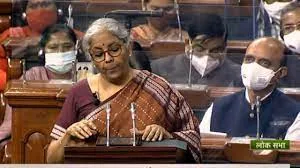Arguing in favor of the ‘crowding-in’ effect of public investment on private investment, the budget has allocated 2.9% of GDP as against 2.2% last year to boost capital expenditure, which is a welcome feature. Further, the budget also allocated another one lakh crore to the states as interest-free loans over and above the regular loans to be given, to give a boost exclusively to infrastructure development. There is thus an overall increase of 4% in the share of GDP towards public investment on Capex.
This estimated investment of Rs 10.68 cr meant for funding various infrastructure projects, which is by far the largest ever public investment in a given fiscal, is hoped to generate growth in employment besides creating fresh demand for manufactured goods, not only this financial year but also in the years to follow.
However, this whole assumption, according to some economists, posits two challenges. Given the fact that the budget aims to reduce the fiscal deficit from 6.9% in the current year to 6.4% in 2022-23, the first obvious challenge is the mobilization of resources to fund the investment. As against the estimated borrowings of Rs 12.5 lakh crore in the last budget, this year’s borrowings are pegged at Rs 14.95 crore. It will be an uphill task for the RBI to mobilize such sums from the market, while the Central Banks all over the world are withdrawing the extraordinary accommodation that they extended to overcome the threat posed by the Covid-19 pandemic since early 2020. In such a scenario, will the additional tax and non-tax revenues be sufficient to finance the envisaged investment?
The second challenge is the generation of employment, for the proposed infrastructure projects appear to be less labor-intensive and more machinery-driven. Added to this predicament, the budget has ironically slashed the allocation for the rural employment program under the Mahatma Gandhi National Rural Employment Guarantee Act by 25% over last year—from Rs 98,000 cr under the revised estimates of 2021-22 budget to Rs 73,000 cr—while social scientists demanded a similar scheme for addressing urban unemployment too. As against these apprehensions, the government is perhaps expecting to create more employment opportunities under the PLI schemes offered to various manufacturing sectors. But some are of the opinion that it is too early to claim the success of these schemes.
While the ongoing pandemic necessitated allocation of funds for strengthening the public health system, both urban and rural, the overall allocation for Health Ministry stood at a disappointing level of Rs 83,000 cr, which is less by Rs 1,000 cr to the revised estimates for 2021-22. Even the allocation for health research witnessed a meager rise of 3.9% while the need for continuing Covid-19 related research and vaccine development remained critical.
The only solace in this regard is the proposal to establish 23 telehealth centers to provide mental health services in collaboration with the National Institute of Mental Health and Neurosciences, Bengaluru duly supported technologically by the International Institute of Information Technology. However, there is a missing link even in this much-desired program: the rural population that is not digitally enabled may not be able to avail of these services.
Addressing the ongoing debate on digital assets, the budget proposes to tax the income net of the cost of acquisition from the transfer of virtual currency at the rate of 30%. Simultaneously, the finance minister proposed to introduce digital currency through RBI leveraging Blockchain and other technologies for creating a “more efficient and cheaper currency management system”. Going ahead with its digitization theme, the budget also proposes to establish a digital university on a networked hub-spoke model to offer world-class quality education to students at their doorsteps. It is also proposed to bring all post offices under the core banking system to help “farmers and senior citizens in rural areas, enabling inter-operability and financial inclusion”.
One notable feature of the budget is its attempt to offset the huge allocation made to infra projects through prudent management of revenue expenditure: the rise in revenue expenditure is contained at 0.9% over fiscal 2022. Another welcome phenomenon of the budget is its spending quality: as against spending of 16% budgeted expenditure in fiscal 2022 and an average of 12.6% during the previous two fiscals to 2022 on Capex, the current year spending stood at 19%, which indeed is said to be the best spending mix witnessed for more than a decade and a half.
That said, we must also take note of the risk posed by the rising inflation. Although the December inflation rate of 5.6% is within the RBI”s inflation band, one cannot afford to ignore the current high wholesale price inflation of 14.2% and the rising global oil prices and their ultimate threat to price stability. Over and above this, the large borrowing envisaged under the budget to fund its Capex program is bound to adversely impact inflation in the days ahead. This is, of course, a challenge to the RBI.
Nevertheless, the budget is a bold effort at generating growth through public investment, with a conscious eye on fiscal consolidation—the script indeed remains the same as that of the last year. Of course, its success depends on the efficacy with which its plans are executed, and importantly, mobilization of resources that is likely to be a big challenge in the pandemic-effected world economy.
So, let us hope for the best.

No comments:
Post a Comment